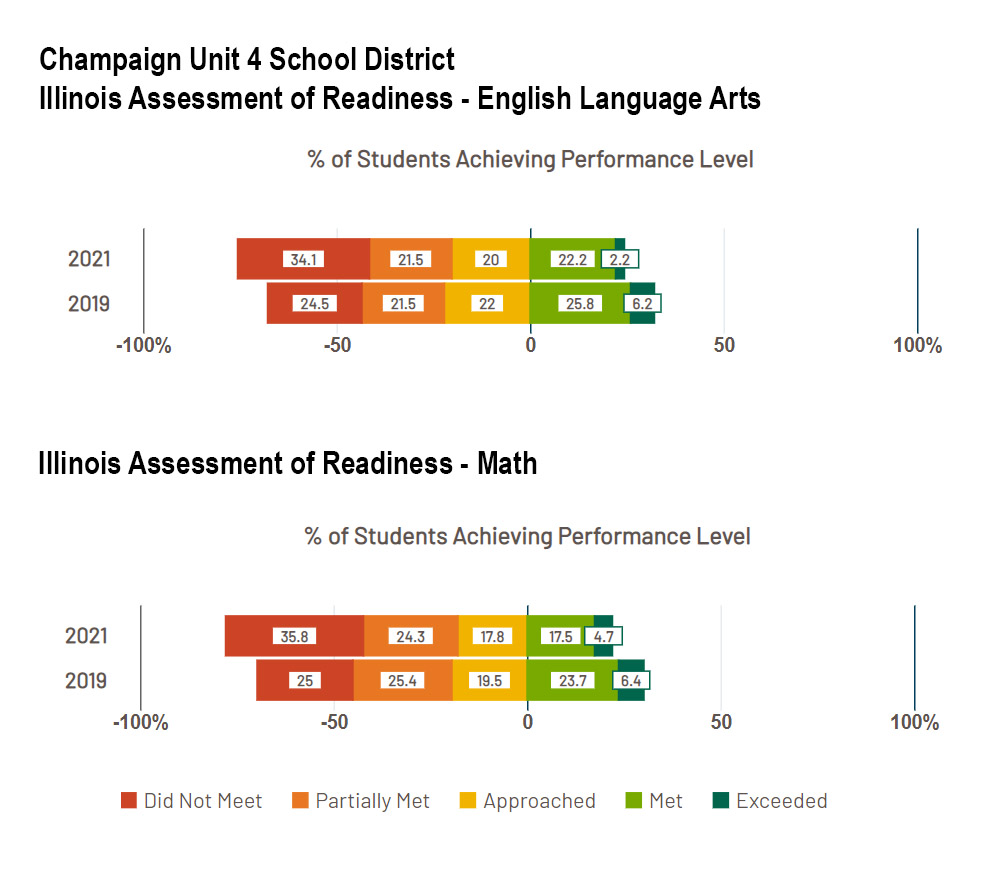CHAMPAIGN — The first pandemic-era standardized test results are out. Student achievement dropped all over Illinois, including in local school districts.
Champaign Unit 4 fifth grade teacher Kim Tate sees pandemic stress as one reason behind the test score decline.
“There’s that element of, ‘I have other priorities and concerns and even trauma.’ Because I have students currently who have lost a family member – a parent,” Tate says. “That does affect the mentality you bring when you’re taking a test.”
Tate, who teaches at the International Prep Academy, thinks some students likely made careless mistakes. Others really are missing key skills they would normally have learned, but she believes teachers can fill those skill gaps.
The Illinois State Board of Education released district-level results for the 2020-2021 SAT and Illinois Assessment of Readiness (IAR) last week. The IAR is a standardized test taken by third through eighth graders.
Before the pandemic, about one in three Unit 4 School District students tested at their grade level for language arts in the IAR. Last spring, the percentage of students testing at or above grade level dropped to one in four.
This decline was slightly more precipitous in Champaign than in the state as a whole. Statewide, language arts IAR scores dropped by 19 percent, compared to Champaign’s 24 percent drop.
Math scores followed similar trajectory, with a 26 percent decline in Champaign.
An incomplete picture

Unit 4 Chief Communications Officer Stacey Moore says not to read too much into these test score declines. That’s because only 40 percent of Unit 4 students actually took the tests last year.
“It is difficult to utilize the spring assessment results as an accurate measure of our students’ achievement or to use the data as a comparison to previous years results,” Moore says.
In normal years, almost all Champaign students take the IAR. Then during the first wave of COVID-19 in the spring of 2020, the state scrapped all standardized tests. Schools got some flexibility in how to administer in-person tests in the spring of 2021, with about 10 percent of schools opting to postpone testing until this fall.
Champaign administered the IAR to in-person students and allowed remote students to come into school on those days. The result was a 41.7 percent participation rate in the math IAR and a 40.7 percent rate in the English and language arts version.
All students are back to learning in-person this fall, with the exception of those quarantining after COVID cases or contact. Moore says this allows Unit 4 to get a clearer picture of where students need academic help.
“Unit 4 started the 2021-22 school year with a focus on our students using local assessments while addressing the ongoing social emotional impacts of the pandemic,” Moore says.
Stress distracts students

University of Illinois social work professor Kate Melissa Wegmann isn’t surprised by the statewide score declines.
Wegmann researches how students cope after disasters, among other topics, and teaches about public school policy.
COVID-19 disrupted everything about school, Wegmann explains. Teachers struggled to teach in a new format. Administrators scrambled to fill computer and internet divides. Parents faced unforeseen decisions about who would watch their child while they went to work.
And the crisis took a toll on student mental health.
“The pandemic has caused a number of unique barriers to learning, and it’s also exacerbated mental and emotional barriers to learning that were already in place for some kids,” Wegmann says.
“If worrying about whether your grandmother is going to make it, or the economic consequences of the pandemic, are taking up cognitive space, that space isn’t available for learning.”

Kim Tate has seen this phenomenon firsthand among the fifth graders she teaches at Unit 4’s International Prep Academy. She sees students making mistakes on content they know, and they confirm her observation when they grade their own work.
Tests don’t rank as a high priority when a student has lost their mother and the world they knew, she says.
Many students have lost confidence as well during the pandemic, Tate has noticed.
“I’m seeing a lot of frustration on the part of the learner. That was one of the missing pieces. Perseverance and a growth mindset are hard to develop remotely,” Tate says.
For example, she might ask students questions about a text they are reading. Students can provide answers from within the text. When Tate asks them to make inferences outside the text about how the character might feel, students give up.
This is Tate’s fourth year teaching fifth grade, and she has never seen so many tears of frustration, especially during tests.
She’s working to build back up student confidence. Those who returned to in-person earlier are recovering their confidence and are better able to apply what they know to new topics.
Money for change
While pandemic hardships have shown up in Illinois test scores, schools also have a unique chance to do something about them.
Unit 4 administrators are in the middle of applying for American Rescue Plan Elementary and Secondary School Emergency Relief (ARP ESSER, or ESSER III) dollars. This third and largest round of school pandemic relief includes $5 billion for Illinois schools.
Tate hopes to see Unit 4 use this money towards “fun” extended school programming.
“It can’t look like school traditionally does. It has to be a reflection of what students are interested in and what they’re passionate about. Are you passionate about storytelling? Are you passionate about poetry?” Tate explains.
Tate created a program like this in the past with two other teachers and knows what works. They noticed that some students at their school were missing key reading and math skills. It was difficult to catch these students up in regular school hours, so the teachers launched a six-week “breakfast club.”
The teachers met with students for a few hours every Saturday, fed them and taught them using unique lesson plans. One involved analyzing photos to learn how to analyze written texts.
Students chose their focus for the six-week program. Almost always, students chose the skill the teachers agreed they needed work in. Having choice, though, helped students set goals for themselves and stay motivated.
Every student tested higher after the program than they did beforehand, Tate says. And it was so appealing that even students on track for their grade signed up.
Tate and her coworkers eventually stopped the initiative when they ran out of money, she says. They were buying some of the food themselves, and it was no longer sustainable for them.
As a student mental health researcher, Wegmann would like to see schools spend money on helping students through trauma. She says a successful program would teach students how to express and handle their emotions through social emotional learning. It would also rebuild the school community and provide behavioral supports for students who act out.
The Champaign Unit 4 School District held public listening sessions for how it should spend American Rescue Plan dollars. Those sessions have wrapped up, and administrators are working on recommendations to present to the Board of Education.
Unit 4 spokesperson Stacey Moore says the public can still provide feedback, including after the district starts spending the money.
“The public listening sessions for ESSER III/ARP have ended but public participation in the process is encouraged and welcomed. We want parents, community members, staff and students to feel that they are always a part of the conversation regarding the best use of these funds,” Moore says.
Emily Hays is a reporter for Illinois Public Media. Follow her on Twitter @amihatt.

